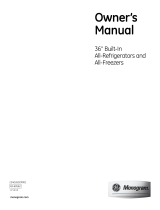
49-60615-4 5
30” Bottom-Freezer
IMPORTANT SAFETY INSTRUCTIONS
READ AND SAVE THESE INSTRUCTIONS
CONNECTING ELECTRICITY
Do not, under any circumstances, cut or remove the
third (ground) prong from the power cord. For personal
safety, this appliance must be properly grounded.
The power cord of this appliance is equipped with a
3-prong (grounding) plug which mates with a standard
3-prong (grounding) wall outlet to minimize the possibility of
electric shock hazard from this appliance.
Have the wall outlet and circuit checked by a qualified
electrician to make sure the outlet is properly grounded.
Where a standard 2-prong wall outlet is encountered, it
is your personal responsibility and obligation to have it
replaced with a properly grounded 3-prong wall outlet. Do
not use an adapter.
The refrigerator should always be plugged into its own
individual electrical outlet which has a voltage rating that
matches the rating plate.
A 115 Volt AC, 60 Hz, 15- or 20-amp fused, grounded
electrical supply is required. This provides the best
performance and also prevents overloading house wiring
circuits which could cause a fire hazard from overheated wires.
Never unplug your refrigerator by pulling on the power cord.
Always grip plug firmly and pull straight out from the outlet.
Immediately discontinue use of a damaged supply cord.
If the supply cord is damaged, it must be replaced by a
qualified service professional with an authorized service
part from the manufacturer.
When moving the refrigerator away from the wall, be
careful not to roll over or damage the power cord.
WARNING
Electrical Shock Hazard.
Plug into a grounded 3-prong outlet
Do not remove the ground prong
Do not use an adapter
Do not use an extension cord.
Failure to follow these instructions can result in death,
fire, or electrical shock.
PROPER DISPOSAL OF YOUR OLD REFRIGERATOR
WARNING
SUFFOCATION AND ENTRAPMENT HAZARD
Failure to follow these disposal instructions can result in death or serious injury
IMPORTANT: Child entrapment and suffocation are not
problems of the past. Junked or abandoned refrigerators
DUHVWLOOGDQJHURXVHYHQLIWKH\ZLOOVLWIRU³MXVWDIHZGD\V´
If you are getting rid of your old refrigerator, please follow
the instructions below to help prevent accidents.
Before You Throw Away Your Old Appliance
Ŷ7DNHRIIWKHIUHVKIRRGDQGIUHH]HUGRRUV
Ŷ Leave the shelves in place so that children may not
easily climb inside.
Refrigerant Disposal:
Dispose of appliance in accordance with Federal and
Local Regulations. Flammable refrigerant and insulation
material used requires special disposal procedures.
Contact your local authorities for the environmentally safe
disposal of your appliance.
WARNING
R600a Refrigerant
This appliance contains isobutane refrigerant, R600a,
a natural gas with high environmental compatibility.
However it is also combustible. Please adhere to the
warnings below:
1) When handling, installing and operating the appliance,
care should be taken to avoid damage to the
refrigerant tubing.
2) Servicing shall be performed by factory-authorized
service personnel and component parts shall be
replaced with manufacturer-authorized replacement
components.
3) Refrigeration products contain refrigerants, which
under federal law must be removed prior to product
disposal.
4) Keep ventilation openings in the appliance enclosures
or in the built-in structure clear of obstruction.
5) Do not use mechanical devices or other means to
accelerate the defrosting process.
6) Do not damage refrigerant circuit.
7) Do not use electrical appliances inside the food storage
compartment of the appliance.





















